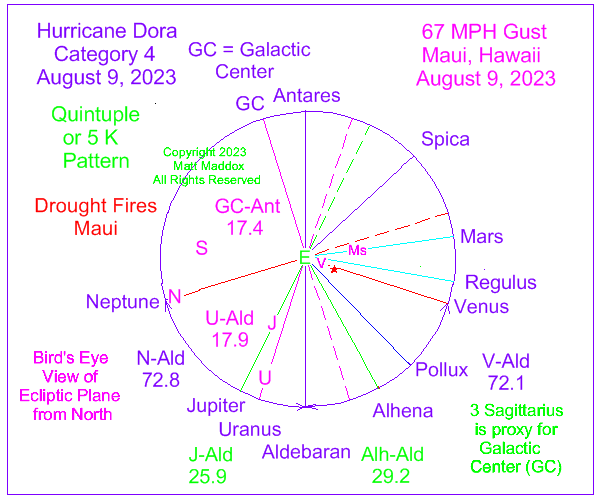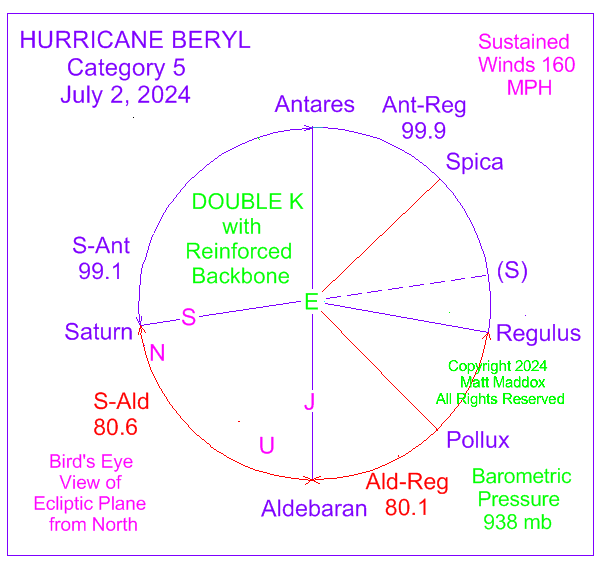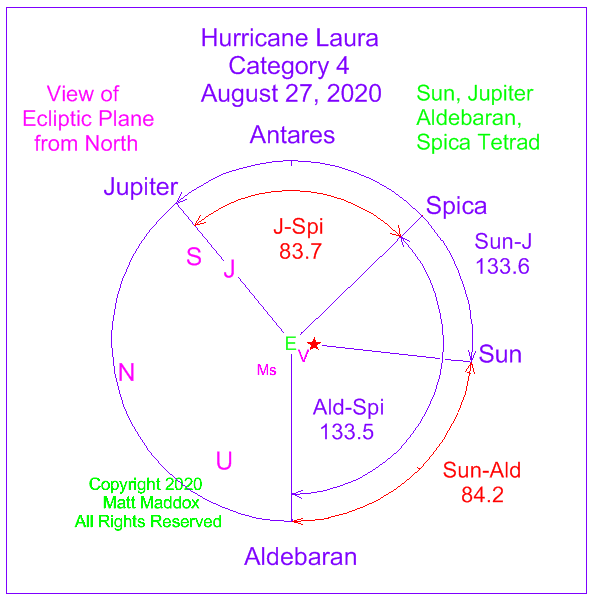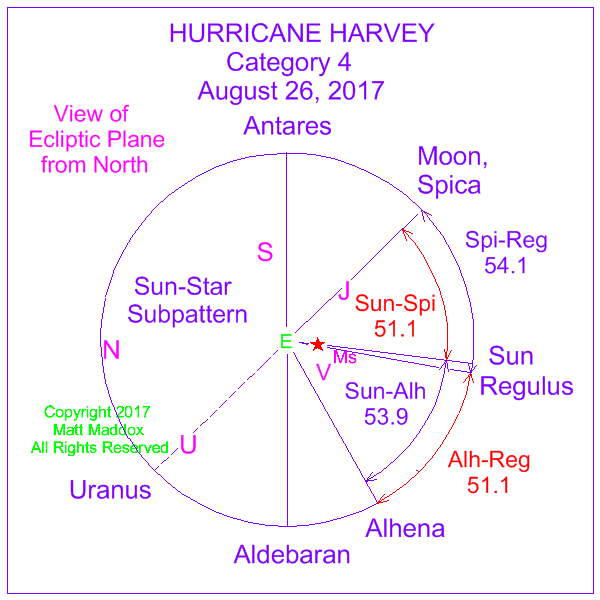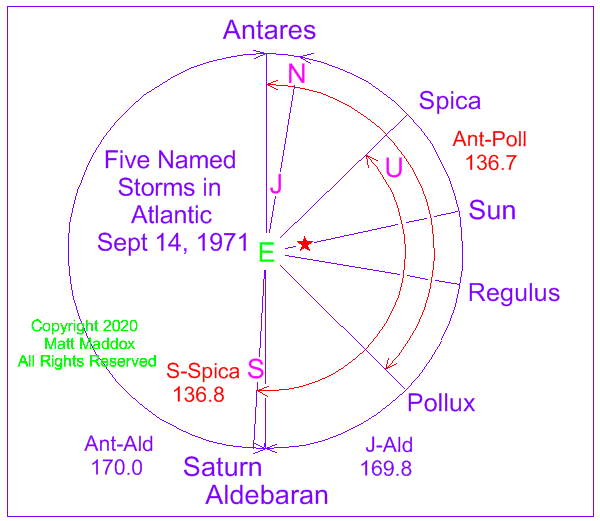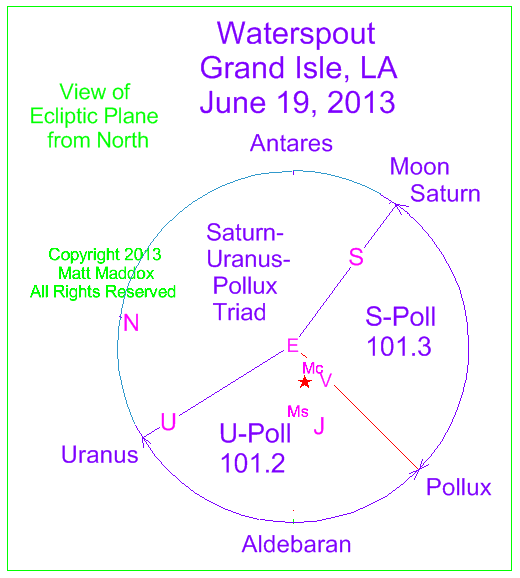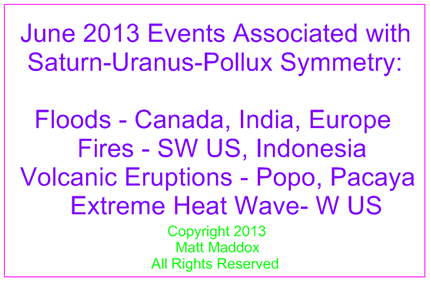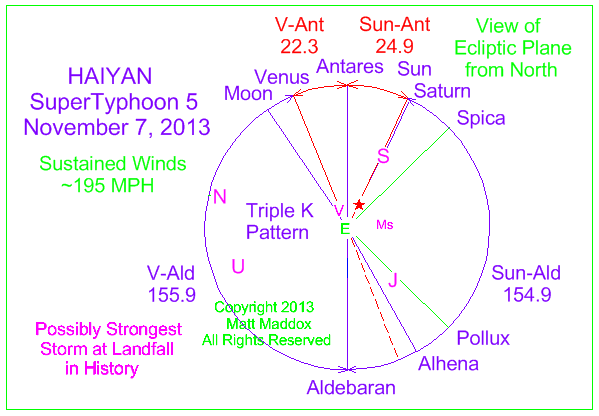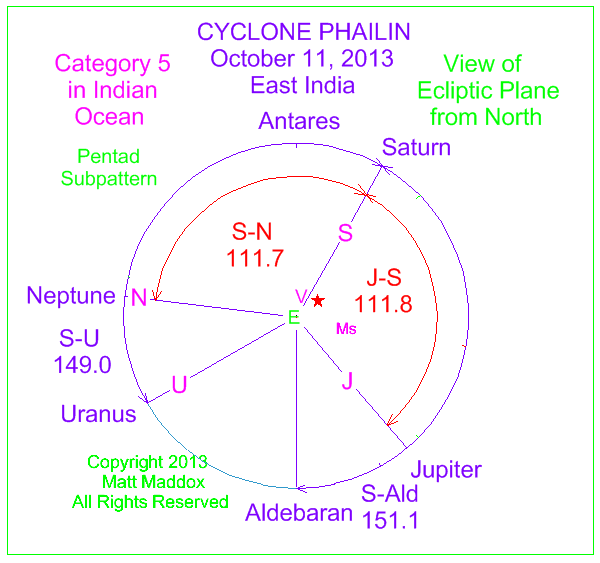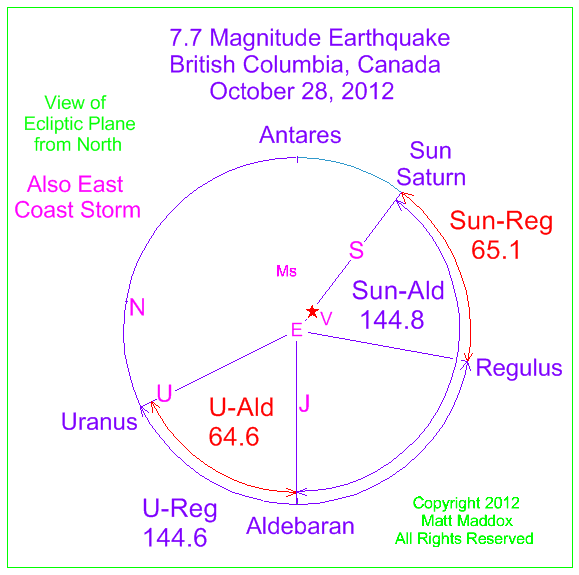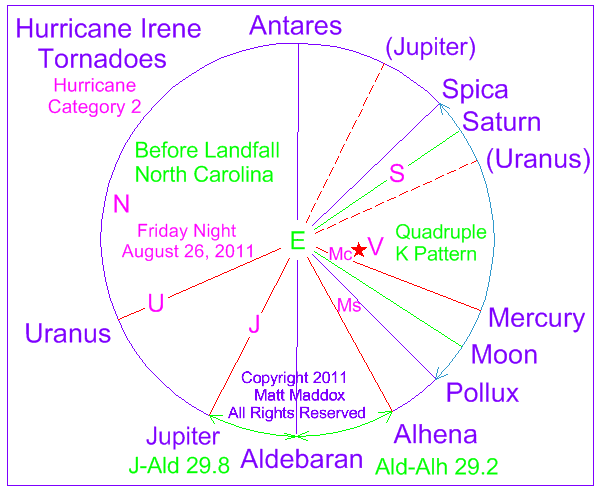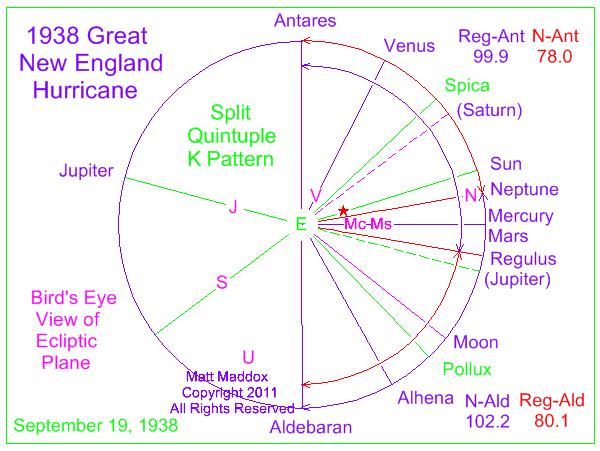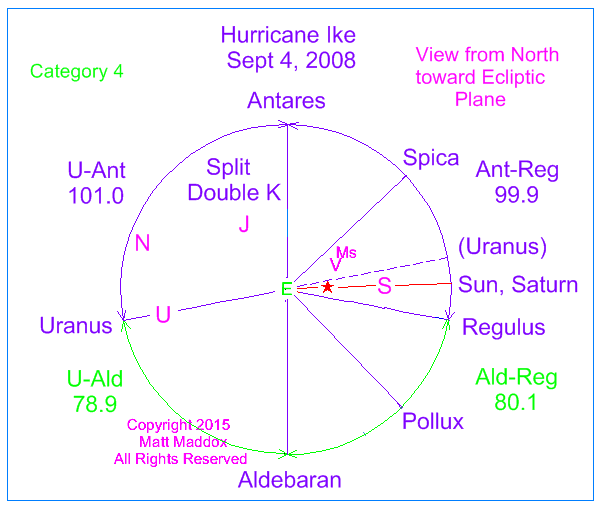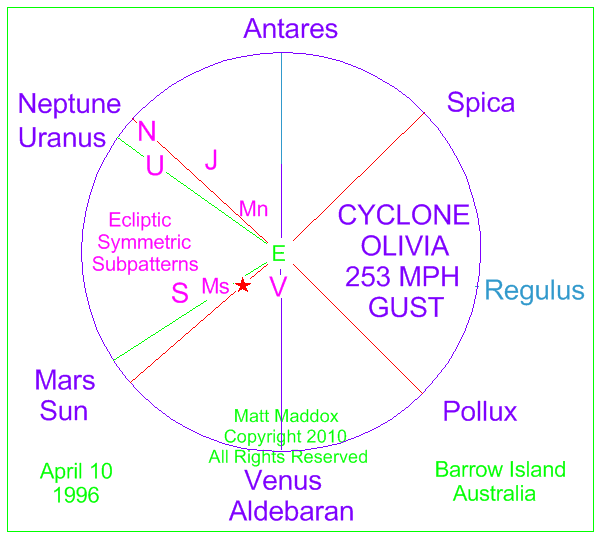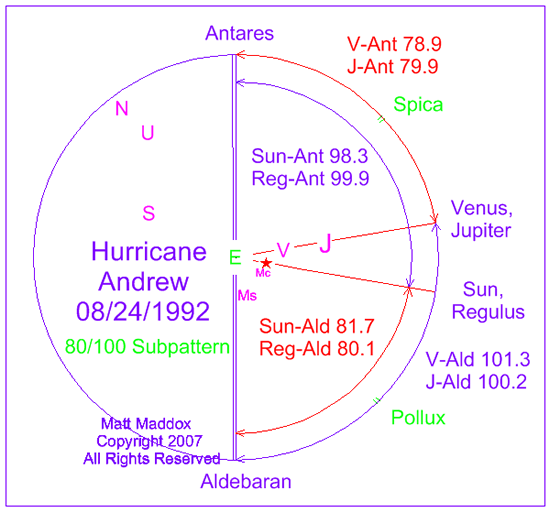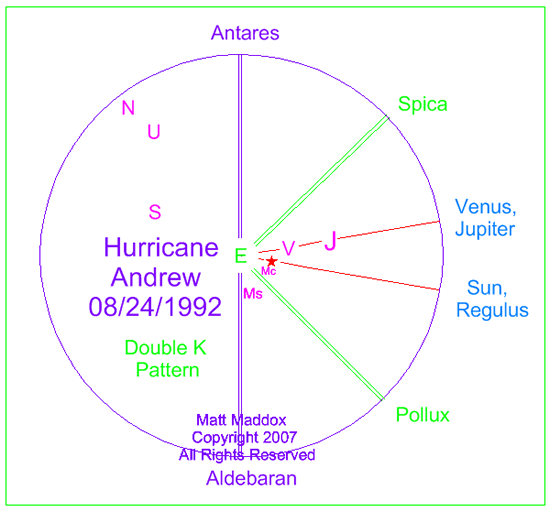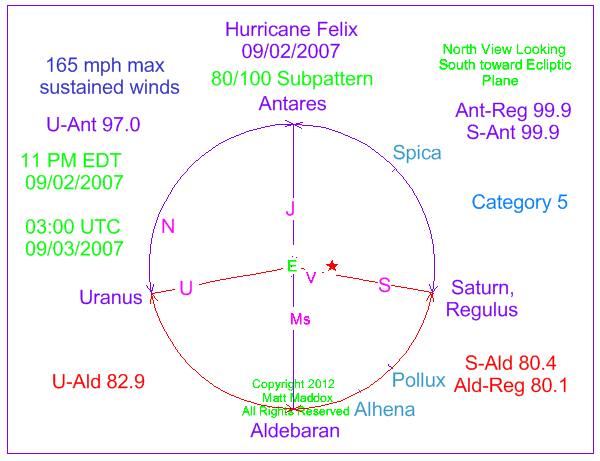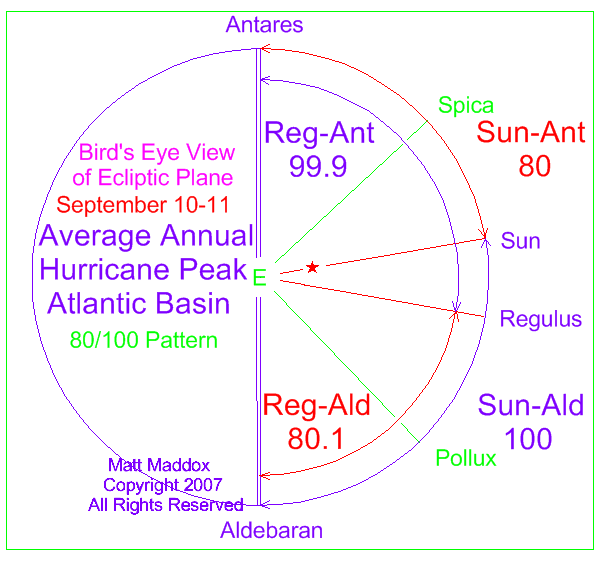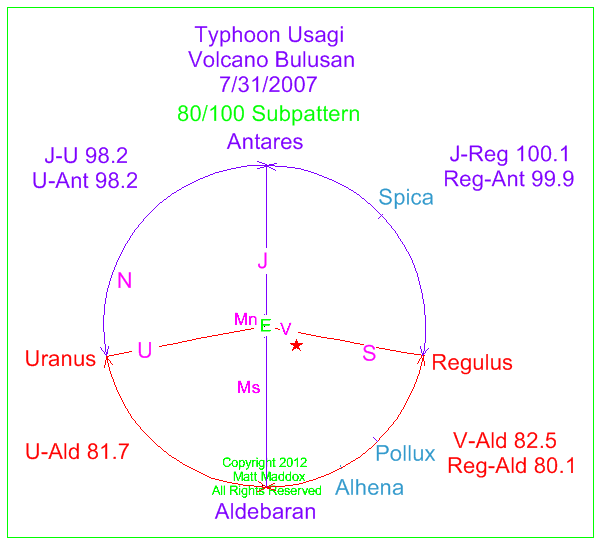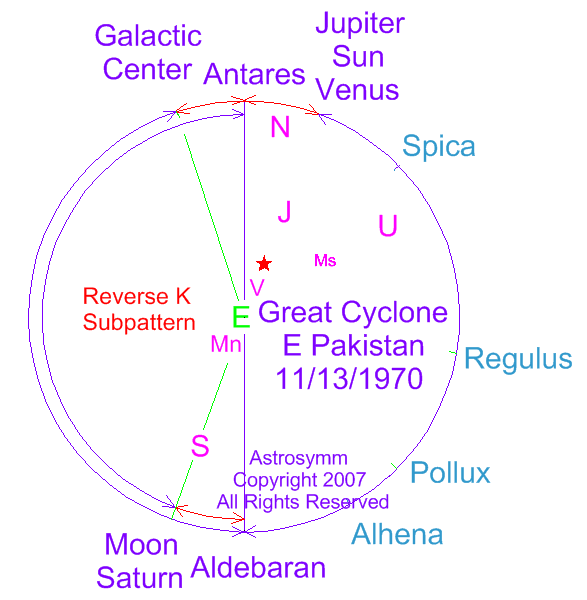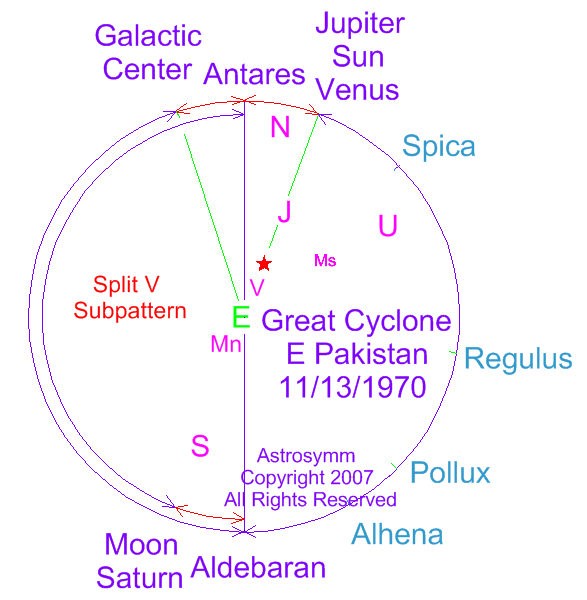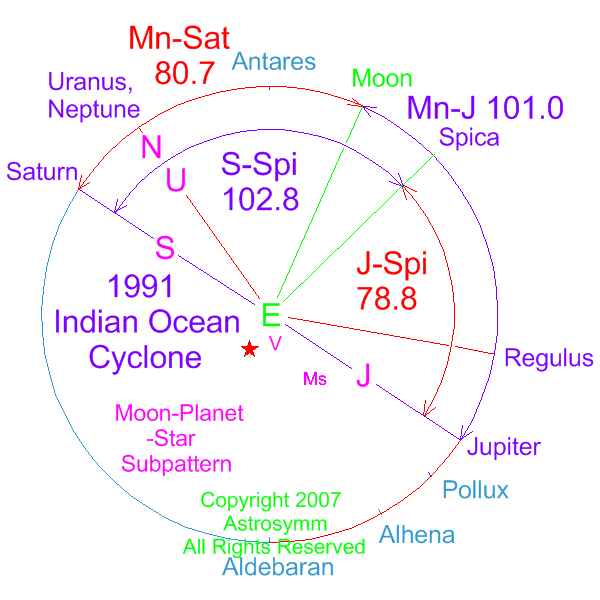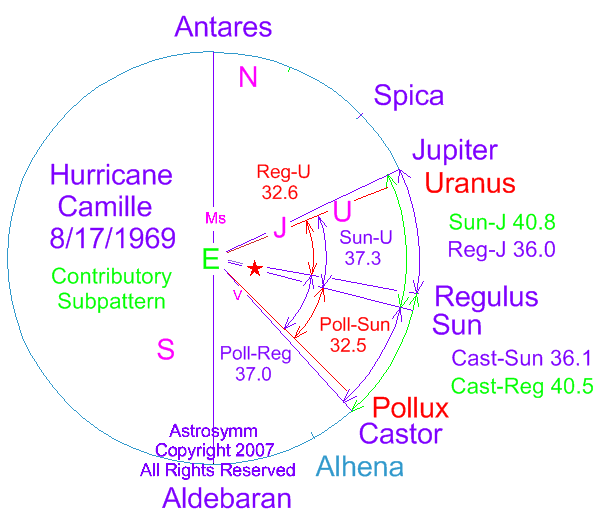| tropical storms |
click here for questions or comments
Uploaded 2023-08-17 HURRICANE DORA & LAHAINA WIND GUSTS Drought Fires Maui - August 8-9, 2023
Note the Quintuple or 5 K pattern associated with Hurricane Dora in the Pacific. Hawaii was caught in between a High Pressure Zone to the North and the Low Pressure of Hurricane Dora to the South which produced the high wind gusts during the drought fires. For a full meteorological discussion please copy and paste: https://www.hawaiinewsnow.com/2023/08/12/hurricane-dora-makes-history-without-making-landfall/
Uploaded 2024-07-20 HURRICANE BERYL Category 5 July 2, 2024 Note the symmetric Double K with Reinforced Backbone of Antares/Aldebaran associated with this intense hurricane. Saturn was symmetrically opposite Regulus and Jupiter was reinforcing the backbone structure. These patterns just happened to occur at the beginning of hurricane season.
HURRICANE LAURA CATEGORY 4 August 27, 2020 Note the angular pairs which have very close agreement. A tetrad (group of 4) including Aldebaran & Spica is a common astronomical pattern correlated with storms,tornadoes and electromagnetic disturbances.
LONG-TERM ASTRONOMICAL PATTERN Summer & Fall 2020 This pattern persists for Summer and Fall of 2020. If the planetary lines are extrapolated, a Triple K pattern emerges. The ecliptic star Pollux is located opposite Saturn.
HURRICANE HARVEY Category 4 August 26, 2017 Note the obvious Double K feature associated with this wind & weather event. The Moon, by virtue of a precise alignment with Spica, reinforced the stellar K composed of Antares, Aldebaran, Spica and Pollux. Please see Katrina midpage for a comparison on Tropical Storms page.
HURRICANE HARVEY Periodic Symmetric Astronomical Pattern This is an annual Sun-Star symmetric pattern which occurs just after the Sun passes Regulus about August 23 each year. But other objects also pass this point on a regular basis, and, when they do, trigger various geophysical events.
FIVE NAMED ATLANTIC STORMS September 14, 1971 There were 5 named storms in the Atlantic September 11-14, 1971. The astronomical pattern was a Double K with Antares & Aldebaran as the backbone. This backbone was reinforced by Saturn and also by a Jupiter/Neptune alignment. The Jupiter-Aldebaran angle was 169.8 degrees while the long-term Antares-Aldebaran angle was 170.0 degrees - a very close match. The Saturn-Spica angle at 136.8 degrees also had a a very good match with Antares-Pollux at 136.7 degrees. These symmetries combined to produce the conditions for five simultaneous storms during this period.
click on diagram for more tornadoes june 2013 events associated with planet-star symmetry
SUPERTYPHOON HAIYAN - CATEGORY 5 November 7, 2013 The Joint Typhoon Warning Center warned of 195 MPH sustained winds and 235 MPH gusts as this storm approached the Philippines. Unisys.com/hurricane reported 170 knot winds and Category 5 status at 11/07/18Z or 1800 UTC. Various news agencies are reporting this as the most powerful storm in history at landfall. It is known as Yolanda in the Philippines. Spica symmetrically opposite Pollux sets up a single K pattern within the Sun-Earth or ecliptic plane. Saturn symmetrically opposite Alhena sets up a Double K ecliptic plane pattern. Furthermore, the Moon physically opposite Alhena and symmetrically opposite Saturn enhances this second or Double K pattern. In addition, when Sun and Venus are considered, a Triple K ecliptic pattern emerges.
CYCLONE PHAILIN - CATEGORY 5 TYPHOON NARI - CATEGORY 3 October 11, 2013 Note the striking Large Planet-Star symmetry associated with these intense weather events. Jupiter, Saturn and Neptune form a precise planetary triad with angular separations that match within 0.1 degrees. With the addition of Uranus and Aldebaran, a pentad subpattern is formed. Other symmetries include a Double K involving Saturn and 3 ecliptic stars. Also, there are no less than six symmetric pairs of astronomical bodies within the ecliptic plane which exhibit ~135 degree angular separations simultaneously. Four pairs are planet-planet combinations and two pairs are ecliptic star-star combinations. Phailin affected Andhra Pradesh and Orissa states within India. Fortunately, due to massive evacuation, there was little loss of life associated with this storm! As of October 13, 2013 Typhoon Wipha in the Pacific is category four and many of the above mentioned symmetries, with only slight variation, are still active.
hurricane sandy october 28, 2012 earth-view pattern is same as solar-view pattern for mayan prediction date december 21, 2012 the basic mayan astronomical pattern is in place for fall 2012. it consists of a symmetric tetrad - group of four axes - composed of 1) uranus, 2) aldebaran opposite antares, 3) regulus opposite neptune and 4) saturn. for hurricane sandy and the british columbia earthquake, the sun is aligned with saturn, reinforcing that axis. please access the mayan page to see the similarity with the solar-view or heliocentric pattern for the december prediction date.
pacific supertyphoon muifa july 30, 2011 prediction made for date note the triple k subpattern associated with this tropical storm which showed sudden intensification. jupiter was symmetrically opposite alhena. the jupiter-antares angle was 148.4 degrees while the antares-alhena angle is a constant 148.6 degrees. saturn was symmetrically opposite the moon-sun-venus axis and spica is always opposite pollux - relative to the antares-aldebaran axis. please note that this storm fell within the prediction parameters of july 30, 2011. the prediction page states to watch for a distinct spike in geophysical activity in all categories on 7/30/2011. a category 4 storm was predicted. this storm went from tropical storm status to category 5 supertyphoon status in 18 hours- an unusual event! 10 or more tornadoes were predicted- 3 occurred on this day in the us. 4" hail was predicted- 1.75" hail fell in minnesota. a 7.4m earthquake was predicted- a 6.7m occurred on 7/29 and 6.6m occurred on 7/31. a 40,000 ft volcanic eruption was predicted- sicily's mt etna did erupt that day- though it was minor.
clic aqui para: version espagnol, fechas del maya, space shuttle columbia, el nino/la nina
hurricane irene tornadoes august 26, 2011 north carolina note the obvious quadruple k symmetric pattern (within the ecliptic plane) associated with these friday night tornadoes. the symmetric pairs include mercury-uranus, moon-saturn, spica-pollux and jupiter-alhena.
hurricane irene august 24, 2011 hurricane irene had an astronomical 83-year analogue. on september 13, 1928 the category 5 san felipe or okeechobee hurricane hit florida. although it did not travel up the eastern seaboard, it did have many astronomical similarities with irene. both jupiter and uranus- within a few degrees- were at the same point in the sky as irene. both mercury and venus were within 2 degrees of the same point where saturn would be 83 years later. and neptune was in line with regulus- almost exactly opposite where it would be for irene.
most of the symmetries would be different for the two hurricanes, but jupiter would set up a geometric pattern with alhena, and the extrapolated earth-jupiter line would set up a double k subpattern for each storm.
intrasite links tropical storms tornadoes solar system
climate/el nino/la nina nuclear power outage/aviation accidents earthquakes/clear air turbulence
great new england hurricane september 19, 1938 note the comprehensive symmetry associated with this storm which had a forward motion of 70 mph! the 115 mph rotational winds combined with this forward motion to produce effectual 185 mph winds in the northeast quadrant! the storm was also known as the yankee clipper and the long island express. please compare this pattern to the split double k pattern associated with the "perfect storm" of 1991.
hurricane earl - category four august 30, 2010 note the precise tetrad set up by j-u, s, aldebaran and pollux. another subpattern, not shown, is a "split-k" composed of antares, v-spica, sun, pollux and aldebaran.
Hurricane Ike September 4, 2008 This devastating storm is associated with a split double K subpattern. The extrapolated Uranus line and Regulus comprise one K and Spica opposite Pollux the other. The Earth-Sun-Saturn axis splits these two K's. Although the Sun has about an 88 degree angular separation with Antares and 92 degree separation with Aldebaran, yet the powerful Sun-Saturn alignment still allows for an effective perpendicular symmetric subpattern contributing to the intensity of this event.
world record wind gust 253 mph - cyclone olivia april 10, 1996 - australia note the obvious "x" symmetry within the sun-earth or ecliptic plane. the sun and neptune are in mirror-image positions relative to spica and pollux. spica and pollux make up the legs of a stellar k pattern, with the backbone composed of antares and aldebaran. see stars in the ecliptic or solar plane. also, relative to the antares-aldebaran backbone, note that mars and uranus are symmetrically opposite each other. saturn is also symmetric with the k pattern. it is within one degree of the antares-pollux midpoint. finally, please observe the moon-jupiter and also the venus-aldebaran alignments. a symmetric tetrad composed of mn-jupiter, spica, regulus and v-aldebaran contributes to the intensity of this record-breaking storm. the total symmetric pattern results in a geomagnetic field disturbance. to see how charged particles spiral around a disturbed u-shaped magnetic field see the power outage-aviation accident page.
katrina for katrina, note the venus-saturn symmetry with spica and pollux. uranus is symmetric with the antares-aldebaran backbone. and both patterns are symmetric with each other!diffraction is defined as a wave bending around an obstacle. in this case, apparently gravitational energy from jupiter is bent or diffracted by venus!
hurricane ida category two november 8, 2009 please note the almost perfect symmetry of jupiter and saturn with the antares-aldebaran backbone of the k pattern found in the ecliptic plane. uranus and neptune also complete a very nice geometric pattern with the stellar ecliptic k.
hurricane andrew - 1992
andrew on august 24, 1992, when hurricane andrew was lashing florida, venus and jupiter were aligned at 1.1 degrees angular separation. and the sun and regulus were at 1.7 degrees. it was the position of venus/jupiter opposite sun/regulus that resulted in an extremely powerful storm.
humberto similiar to dean, felix september 13, 2007 update the large planet/star subpattern for umberto is almost identical with those for both hurricanes dean and felix. the large planets just don't move much in a one month period. the other objects move faster. umberto was within the predictive window for 9/11/2007. see predictions text link below.
hurricane felix- category 5 september 2, 2007 ecliptic tilt view
hurricane felix- category 5 september 2, 2007
bird's eye view of ecliptic plane
please see description of hurricane flossie below for an understanding of the 80/100 pattern which has been in place since early august 2007. some astronomical changes have occurred since flossie. for more 3-dimensional patterns, see shuttle and nuclear. a category 3 storm was forecast globally for september 2 on august 2, 2007. please see predictions text. don't miss volcano tambora and solar tornado!
average annual hurricane peak atlantic basin september 10-11 a book authored by dr. chris landsea and others shows that the annual peak for north atlantic hurricane activity is on september 10-11.(1) every year on these dates, the sun completes a "v inside k" or "double k" pattern with 5 stars in the ecliptic plane. the overall sun/moon/planet/star pattern will determine the date and intensity for a given hurricane. (1) the reference for the book has been misplaced. it has a bar graph which shows n. atlantic hurricane activity averaged by date for about 100 years. if the reader has knowledge of this publication, please e-mail astrosymm author and this reference will be listed. here is a reference by dr. landsea which will show that atlantic hurricane activity peaks after september 1 on an annual basis: a climatology of intense (or major) atlantic hurricanes, christopher landsea, department of atmospheric science, csu, ft collins, co, 1993 monthly weather review 121, pp 1703-1713, fig 1,2,3
hurricane flossie - august 14, 2007 north view looking south toward ecliptic plane this diagram shows the subpattern with approximately 80 and 100 degree angular separations. there are four main earth-object axes: 1) aldebaran, 2) uranus, 3) jupiter-antares and 4) moon-venus-saturn-regulus. of course the moon alignment was only temporary and not the actual cause of the storm. note the similarity with typhoon usagi below. also please reference hurricane andrew (below) and hurricane katrina. a busy period for geophysical news was anticipated early in 2007 - please note the predictions for the 2nd half of 2007 on the predictions page. in addition, the shuttle is at risk for re-entry overheating at various times. see columbia 3-d symmetry for a fascinating schematic of the astronomical configuration at the time of this memorable accident!
typhoon usagi + volcano bulusan july 31, 2007 on july 31 volcano bulusan in the phillipines was belching ash into the sky while typhoon usagi was churning away in the pacific at 85 knots (1). by august 1 at 00:00 utc, usagi had strengthened to 120 knots with gusts up to 145 knots! note the 80 and 100 degree angular separations with these two concurrent events. both venus and saturn are lined up within 3-4 degrees of the energetic star regulus and jupiter is lined up precisely with antares.
1970 great cyclone east pakistan/bangladesh 20/160 degree subpattern this was a momentous indian ocean storm with an approximate 40 foot storm surge. there was great loss of life as the flood waters inundated the low-lying delta of the ganges and brahmaputra rivers. an infrequent alignment occurred at the height of the storm - saturn-moon-earth-venus-sun-jupiter! however, the key to the storm is where the line-up was located in space. the solar-lunar-planetary line-up was symmetrically opposite to the earth-galaxy center line! both lines show approximate 20 and 160 degree angular separations with the antares-aldebaran axis.
1970 great cyclone two subpatterns there are actually two subpatterns which result from the two intersecting lines. the first subpattern is a "reverse k." the backbone is made up of antares and aldebaran. the two legs are composed of galaxy center, earth and the pair of moon and saturn. the second is a "v" shape composed of galaxy center, earth and the trio of venus, sun and jupiter. this v is split by the antares-aldebaran axis. the "v" subpattern does not refer only to venus, but to several bodies making the "v" pattern. there are several other subpatterns active at the time of this event.
1991 indian ocean cyclone bangladesh in 1991 another great storm hit the same area of the indian ocean. the main country affected was now named bangladesh. this storm also caused a great loss of life. with both storms jupiter and saturn were almost exactly opposite each other in the sky! interestingly, the moon was on the same axis- but opposite orientation - in both storms - about 22-23 degrees from the antares-aldebaran backbone!
four atlantic hurricanes on september 25, 1998 there were four simultaneous hurricanes in the atlantic basin. note that venus was almost at the same point as andrew in 1992. jupiter was on the same axis as it was with andrew, but at a point opposite in the sky.
hurricane camille with camille, note the sextet of jupiter-uranus, sun-regulus and pollux-castor. this sextet is composed of an inner tetrad, or foursome, of uranus, sun-regulus and pollux. another "interlocking" tetrad, or foursome, is made up of jupiter, sun-regulus and castor. note that the three stars are in fixed positions and that the sun, jupiter and uranus move through the sky over a period of time. so this particular pattern can only occur rarely, and briefly when it does happen.
(1) joint typhoon warning service - bulletin july 31, 2007
|
copyright 2007 astrosymm
all rights resrved

